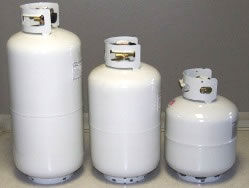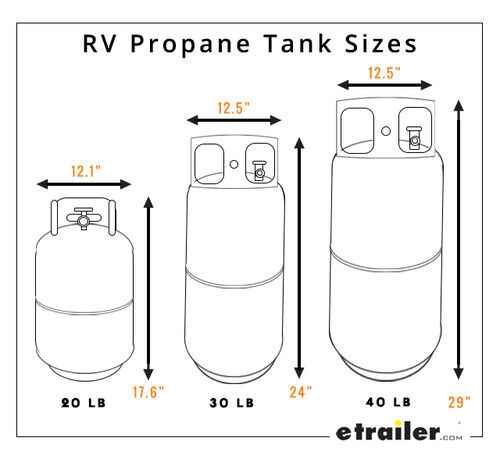Are you looking to make an informed choice between a 20 lb and a 30 lb propane tank? Whether you’re planning your next camping trip, gearing up for a backyard barbecue, or simply ensuring a steady fuel supply for your home, the decision can feel daunting.
But don’t worry, you’re not alone in this! This guide will walk you through the key differences, benefits, and considerations of each tank size. You’ll discover which option best fits your needs, saving you time, money, and future headaches. Get ready to make a decision that keeps your grill fired up and your mind at ease.
Dive in to uncover everything you need to know about choosing the right propane tank for your lifestyle.
Tank Size And Dimensions
Choosing the right propane tank size is crucial for efficiency and safety. Whether you’re grilling, heating, or camping, knowing the dimensions of 20 lb and 30 lb tanks can help you decide which fits your needs best. Both have distinct characteristics that cater to different applications. Understanding their dimensions can make a significant difference in their usage.
20 Lb Propane Tank Dimensions
The 20 lb propane tank is the most common choice for home use. It stands approximately 18 inches tall. Its diameter is around 12 inches. This compact size makes it ideal for backyard grills and small heaters. Easy to transport, it fits snugly in most grilling stations. The size also allows for convenient storage in sheds or garages.
30 Lb Propane Tank Dimensions
The 30 lb propane tank is slightly taller at about 24 inches. It has a diameter of approximately 12.5 inches. This tank is perfect for larger appliances. It offers more gas capacity for extended use. Ideal for RVs and larger outdoor setups. Its size requires more space for storage and transportation. Consider this if you use appliances that demand more fuel.
Weight And Portability
Choosing between a 20 lb and 30 lb propane tank affects weight and portability. A 20 lb tank is lighter and easier to move. The 30 lb option offers more fuel capacity but can be cumbersome for transport.
When choosing between a 20 lb and a 30 lb propane tank, understanding their weight and portability is crucial. Whether you’re planning a camping trip or a backyard barbecue, the ease with which you can move these tanks can make or break your experience. Let’s dive into how each tank measures up in terms of weight and portability.Weight Considerations
The 20 lb propane tank is lighter and typically weighs around 37 pounds when full. This makes it manageable for most people to lift and carry. It’s a popular choice for portable grills and camping. In contrast, a 30 lb propane tank can weigh up to 55 pounds when filled. This added weight can be challenging if you need to move it frequently. However, if you’re planning a longer trip or have higher fuel needs, the extra capacity might be worth the extra pounds.Portability In Different Situations
Think about your specific needs. Are you heading out on a solo camping trip or hauling gear for a large family gathering? A 20 lb tank is often more convenient for quick, solo adventures due to its lighter weight and compact size. For larger gatherings or extended camping, a 30 lb tank offers more fuel, reducing the need for frequent refills. It’s less portable, but if you’re setting up a semi-permanent camp, the extra fuel capacity can be a real advantage.Personal Experience With Portability
I remember a camping trip where I underestimated our propane needs and opted for a 20 lb tank. Midway through the weekend, we had to pack up and find a refill station. That experience taught me to consider not just the weight but how often I’d need to refill. If you’ve ever lugged a propane tank across a campsite, you know how important it is to choose the right size. Consider how far you need to carry it and if you have help. A 30 lb tank might be easier to manage if you have a dolly or another person to assist.Decision-making Tips
Weigh the pros and cons of each tank size based on your specific situation. Do you prioritize ease of transport, or is having more fuel a bigger concern for you? Ask yourself: Will a few extra pounds now save you from headaches later? Or is the ability to easily move the tank around your top priority? Understanding these factors helps you make an informed decision that aligns with your needs. Whether it’s a 20 lb or 30 lb tank, knowing your priorities will ensure your outdoor adventures are smooth and enjoyable.Gas Capacity And Usage
Choosing between a 20 lb and a 30 lb propane tank depends on your gas usage needs. A 20 lb tank is lighter and easier to transport, ideal for small grills or occasional use. Meanwhile, a 30 lb tank offers more capacity, perfect for extended cooking or camping trips.
Understanding the gas capacity and usage of propane tanks is crucial for anyone relying on them for heating or cooking. Whether you’re grilling for a backyard BBQ or powering your RV, knowing how much gas your tank can hold and how long it will last can make all the difference. This section will help you decide between a 20 lb and a 30 lb propane tank by breaking down their gas capacities and usage patterns.20 Lb Propane Tank: Gas Capacity
The 20 lb propane tank is a popular choice for many households. It holds approximately 4.7 gallons of propane. This size is perfect for small to medium grills or patio heaters. You might find yourself needing to refill more often, especially during summer grilling season. However, it’s easy to handle and transport due to its manageable size.20 Lb Propane Tank: Usage
On average, a 20 lb tank can provide around 18-20 hours of cooking time on a medium-sized grill. If you’re an occasional griller, this might be all you need. Imagine hosting a family BBQ; a single tank can comfortably last throughout the day. But what if you’re planning a camping trip? You may need to plan refills depending on your usage.30 Lb Propane Tank: Gas Capacity
The 30 lb tank offers roughly 7 gallons of propane. This extra capacity is perfect for those who frequently use propane or need it for larger appliances. Consider the convenience it offers by reducing the number of trips to refill. It’s especially useful for extended outdoor adventures or when powering multiple devices simultaneously.30 Lb Propane Tank: Usage
A 30 lb tank can run a medium-sized grill for about 28-30 hours. This extended usage is ideal for avid grillers or those who love hosting regular outdoor gatherings. Think about the peace of mind it brings during a camping trip, knowing you won’t run out of fuel. But remember, it’s bulkier, so ensure you have the space and strength for handling. Choosing Between 20 lb and 30 lb Tanks The choice between these tanks boils down to your frequency and type of usage. Are you a weekend griller or a camping enthusiast? Reflect on your lifestyle and needs. Would the larger capacity of a 30 lb tank save you time and hassle, or is the portability of a 20 lb tank more important to you? Final Thoughts Your decision should align with your personal needs and circumstances. Consider how often you use propane and what you’re using it for. Could a larger tank offer more convenience, or is portability your top priority? Making the right choice ensures you enjoy consistent and efficient fuel usage.Cost And Affordability
Choosing between a 20 lb and 30 lb propane tank involves understanding costs. Each option presents different benefits and expenses. Analyzing these factors helps in making a cost-effective decision. This section dives into the financial aspects of both tank sizes.
Initial Purchase Price
The initial purchase price is a crucial consideration. A 20 lb propane tank typically costs less upfront. This makes it more accessible for many buyers. A 30 lb tank, while pricier, offers more capacity. This may justify the higher expense for frequent users.
Refill Costs
Refilling costs differ significantly between the two sizes. A 20 lb tank requires frequent refills. This can increase overall costs over time. A 30 lb tank holds more propane, needing fewer refills. This could lead to savings in the long run.
Cost Per Gallon
The cost per gallon of propane is another factor. Larger tanks sometimes provide a better rate per gallon. This can make the 30 lb tank more economical over time. A 20 lb tank may not offer the same cost efficiency per gallon.
Long-term Affordability
Considering long-term affordability is essential. A 20 lb tank might be cheaper initially. Yet, frequent refills can add up. A 30 lb tank’s higher initial cost might balance out. Especially for heavy users, this could mean savings over time.
Refilling And Exchange Options
When it comes to choosing between a 20 lb and a 30 lb propane tank, understanding the refilling and exchange options is crucial. Both tanks offer unique advantages and knowing your options can save you time and money. Whether you’re a frequent griller or a seasonal camper, these insights will help you decide which tank best suits your lifestyle.
Convenience Of Refilling
Refilling a propane tank is often more cost-effective than exchanging it. If you frequently use propane, a 30 lb tank might reduce your trips for refills due to its larger capacity. Many local gas stations and camping supply stores offer refilling services, making it a convenient option.
Refilling also allows you to pay for the exact amount of propane you need. You don’t have to worry about returning a half-full tank, which is often the case with exchanges. Plus, you maintain ownership of your well-maintained tank.
Pros And Cons Of Exchange Programs
Exchange programs are widely available and offer a quick way to get a full tank. They’re particularly handy if you’re in a rush or if your tank is outdated. Many grocery stores and home improvement centers have exchange stations, making this an accessible option.
However, exchanges can be more expensive per pound of propane. You also risk receiving a tank that’s not in the best condition. If appearance and condition are important to you, refilling might be a better choice.
Cost Considerations
Refilling a 20 lb tank typically costs less than a 30 lb tank, but the price per pound is usually similar. With exchange programs, the cost difference between 20 lb and 30 lb tanks is more noticeable. A larger tank can offer better value if you’re a heavy user.
It’s wise to compare prices at different locations. You might find that your local station offers competitive rates compared to larger chain stores. Always factor in the convenience and proximity of the service.
Environmental Impact
Refilling your propane tank is generally more environmentally friendly. It reduces the need for manufacturing new tanks and minimizes waste. On the other hand, exchange programs often involve transporting empty tanks back and forth, contributing to a larger carbon footprint.
If sustainability is a priority for you, consider investing in a good-quality tank and sticking to refills. It’s a small step towards reducing your environmental impact while enjoying your outdoor activities.
Do you prefer the convenience of an exchange or the cost savings of a refill? The choice between a 20 lb and 30 lb propane tank ultimately depends on your usage patterns and priorities. Whatever you decide, understanding these options will help you make an informed choice.
Safety Considerations
Choosing the right propane tank size involves safety considerations. A 20 lb tank is lighter and easier to handle, suitable for smaller grills. A 30 lb tank provides more fuel capacity, ideal for longer use but requires careful handling due to its weight.
Proper storage and regular inspections are essential for both sizes.
When deciding between a 20 lb and a 30 lb propane tank, safety should be a top priority. Understanding the safety considerations can help you make an informed choice that suits your needs. Whether you’re using propane for grilling, heating, or camping, ensuring safety will provide peace of mind and prevent potential hazards.Transportation And Handling
Transporting propane tanks requires careful handling. A 20 lb tank is more manageable for most people, reducing the risk of accidents during lifting or moving. If you’ve ever tried to load a 30 lb tank into your car, you know how challenging it can be. Ensure the tank is upright and secure during transport. This prevents it from tipping over and potentially leaking. Always use a proper propane tank holder in your vehicle to keep it stable.Storage Guidelines
Storing propane tanks safely is crucial. Both 20 lb and 30 lb tanks should be kept in well-ventilated areas, away from direct sunlight and heat sources. A friend of mine once stored a tank in a cramped garage corner, only to find out later that this was a risky move. Consider outdoor storage options, like a shed or a special propane tank storage box. These options provide ventilation while keeping the tank protected from the elements.Pressure And Leak Checks
Regularly checking your tank for leaks can prevent accidents. A simple soap and water solution applied to the tank’s connections can reveal leaks through bubbles. I learned this tip from a seasoned camper who swears by it before every trip. Always make sure the pressure gauge is functioning correctly. A faulty gauge can give you false readings, leading to potential overuse or unsafe pressure levels.Filling And Refilling Practices
Refilling your propane tank should be done by a professional. Overfilling can cause gas expansion and increase the risk of leaks. Remember the time you overfilled a drink and it spilled everywhere? Imagine that with propane—it’s much more dangerous. Ask the attendant about the tank’s weight after filling to ensure it’s not overfilled. This small step can prevent major safety issues.Emergency Preparedness
Being prepared for emergencies can make all the difference. Keep a fire extinguisher nearby when using propane tanks. My neighbor once extinguished a small flare-up during a barbecue, thanks to having an extinguisher on hand. Educate your family or group on what to do if a leak or fire occurs. Quick, calm action can prevent injuries and damage. Do these safety considerations change your perspective on which tank to choose? By prioritizing safety, you ensure enjoyable and worry-free propane use.Application And Suitability
Choosing between a 20 lb and a 30 lb propane tank depends on your needs. Each has its own set of applications and suitability. Understanding these can help you make the right choice. Whether for grilling, camping, or heating, each tank serves different purposes. Let’s explore which fits your situation best.
Usage In Outdoor Grilling
The 20 lb propane tank is ideal for small grills. It is easy to handle and store. Perfect for backyard barbecues or picnics. A 30 lb tank is better for larger grills. It lasts longer during extended cooking sessions. Great for big gatherings or events.
Camping And Rv Adventures
For short camping trips, a 20 lb tank is sufficient. It is portable and easy to transport. Fits well in most camping gear. A 30 lb tank suits longer RV trips. Provides more fuel for extended stays. Reduces the need for frequent refills.
Home Heating And Appliances
A 20 lb tank can power small heaters. Suitable for temporary heating needs. A 30 lb tank powers larger heaters and appliances. Useful for more extended heating requirements. It supports more significant energy needs efficiently.
Cost Efficiency Considerations
Initial costs for a 20 lb tank are lower. It is economical for occasional use. A 30 lb tank is cost-effective in the long run. Reduces frequent purchase costs. Offers better value for regular users.
Space And Storage Needs
The 20 lb tank requires less storage space. Ideal for small homes and apartments. A 30 lb tank needs more space. Suitable for larger storage areas. Consider your space before choosing.

Credit: www.facebook.com
Environmental Impact
The environmental impact of propane tanks is an important consideration. Choosing between a 20 lb and a 30 lb propane tank affects this impact. Understanding how each size impacts the environment helps make informed choices.
Size And Material Consumption
A 30 lb propane tank uses more materials than a 20 lb tank. More steel and other resources are needed. This increases the carbon footprint. Larger tanks require more energy to manufacture. A 20 lb tank uses fewer resources. This makes it a slightly greener option.
Transportation And Fuel Efficiency
Larger propane tanks are heavier. They consume more fuel during transportation. This leads to higher emissions. A 20 lb tank is lighter. It requires less energy to transport. This results in lower emissions. Choosing a smaller tank can reduce environmental impact.
Frequency Of Refilling
A 30 lb tank holds more propane. It requires fewer refills than a 20 lb tank. Fewer trips to refill means lower emissions. This can offset the larger tank’s initial environmental cost. A balance between size and refilling frequency is key.
Longevity And Recycling
Both tank sizes can be recycled. But larger tanks may last longer. Longer lifespan means less frequent replacements. This reduces waste. Smaller tanks may need replacing sooner. Recycling helps, but longevity reduces environmental strain.
Durability And Longevity
Durability and longevity are essential factors in choosing propane tanks. They determine how long your tank lasts and withstands external conditions. Understanding these aspects ensures you make a wise purchase.
20 Lb Propane Tank Durability
The 20 lb propane tank is compact and sturdy. It handles wear and tear effectively, making it reliable for regular use. Its smaller size offers easy handling and transport.
These tanks often have robust materials. They resist dents and scratches well. This makes them suitable for camping and outdoor activities.
30 Lb Propane Tank Durability
The 30 lb propane tank offers a solid build. It stands firm against rough conditions. This larger tank is ideal for extended use.
Made from durable materials, it withstands pressure and impacts. It is a preferred choice for home or larger outdoor setups.
Longevity Of 20 Lb Propane Tank
The 20 lb tank lasts for many refills. Its longevity depends on usage and maintenance. Proper care extends its lifespan significantly.
Regular checks prevent leaks and damage. With good maintenance, these tanks serve well for years.
Longevity Of 30 Lb Propane Tank
The 30 lb tank has a longer lifespan. Frequent inspections ensure it remains in top condition. This tank supports more propane refills.
Its longevity makes it cost-effective over time. Proper storage and handling keep it functional longer.

Credit: www.propane101.com
User Reviews And Experiences
Users often debate the 20 lb and 30 lb propane tanks. Many prefer the 20 lb for its portability. Others choose the 30 lb for longer use. Reviews highlight the convenience and usage differences. Personal experiences vary based on needs and preferences.
Choosing between a 20 lb and a 30 lb propane tank can be a tricky decision. User reviews and experiences offer valuable insights into what works best in real-world situations. People who have used these tanks share their stories, making it easier for you to decide which tank suits your needs. Let’s dive into what users are saying about their experiences with each type of tank.Reviews On Convenience And Portability
Many users appreciate the 20 lb tank for its portability. It’s easier to carry and fits snugly into most grills and camping setups. One user mentioned that the 20 lb tank is perfect for spontaneous trips because it’s light enough to toss in the trunk without hassle. On the other hand, some users feel the 30 lb tank offers better value for longer trips, despite being heavier.Feedback On Usage Duration
A common theme in reviews is the duration of usage each tank offers. Users often find the 30 lb tank more suitable for extended use. Imagine going on a week-long camping trip and not having to worry about refilling the tank. That’s the peace of mind a 30 lb tank offers. However, if you mostly engage in short grilling sessions or weekend outings, a 20 lb tank might suffice.Insights On Cost-effectiveness
Cost is another factor where user experiences offer clarity. Some users report that filling a 30 lb tank is more economical in the long run. They argue that fewer trips to the refill station save time and money. Yet, others highlight the upfront cost of a 30 lb tank can be a deterrent, especially for those who only grill occasionally.Safety Concerns And Experiences
Safety is paramount when dealing with propane. Users often stress the importance of proper handling, regardless of tank size. Some users feel that the 20 lb tank is easier to manage, reducing the risk of accidents during transportation. A few have shared their experiences of safely using a 30 lb tank, emphasizing the need for secure mounting and careful handling.Practical Considerations From Users
A practical insight shared by users is the space requirement. A 30 lb tank needs more room, which can be a challenge in compact spaces. One user cleverly solved this by creating a designated spot in their garage for the larger tank. How much space can you dedicate to a propane tank, and does it align with your lifestyle? Your choice between a 20 lb and a 30 lb propane tank ultimately depends on your personal needs and circumstances. User reviews provide a treasure trove of information that can guide your decision. What insights resonate with you?
Credit: www.etrailer.com
Frequently Asked Questions
What Is The Difference Between 20 Lb And 30 Lb Propane Tanks?
20 lb tanks are smaller and more portable. 30 lb tanks hold more propane, lasting longer for heavy use.
How Long Does A 20 Lb Propane Tank Last?
A 20 lb propane tank lasts 18-20 hours on a medium grill. Cooking time varies with usage.
Are 30 Lb Propane Tanks Suitable For Rvs?
Yes, 30 lb tanks are great for RVs. They provide more fuel for appliances and longer trips.
Can I Use A 30 Lb Tank For A Grill?
Yes, you can use a 30 lb tank for grills. It offers extended cooking time compared to 20 lb tanks.
How Do I Choose Between 20 Lb And 30 Lb Propane Tanks?
Choose based on usage. 20 lb for portability and quick tasks; 30 lb for longer cooking or heavy use.
Conclusion
Choosing between a 20 lb and 30 lb propane tank depends on your needs. Smaller tanks are more portable and easier to store. They suit quick camping trips or small grills. Larger tanks provide longer usage and fewer refills. Ideal for frequent grillers or extended trips.
Consider the weight and space availability. Both options have their advantages. Think about your usage and convenience. Make the right choice for your outdoor activities. Enjoy efficient and reliable energy for cooking or heating. Always prioritize safety and follow propane handling guidelines.





